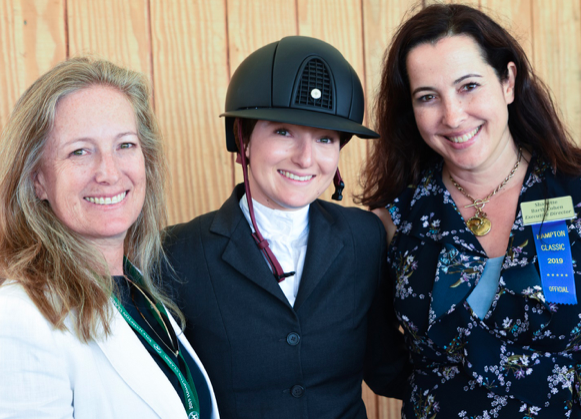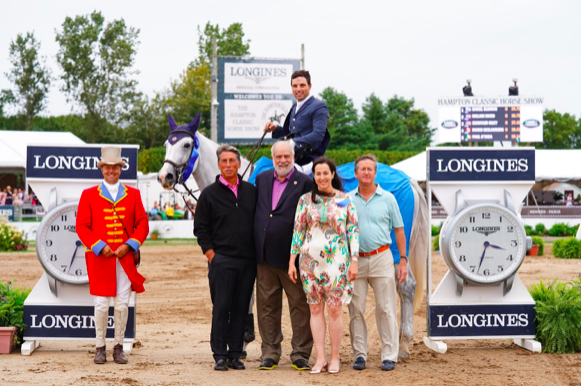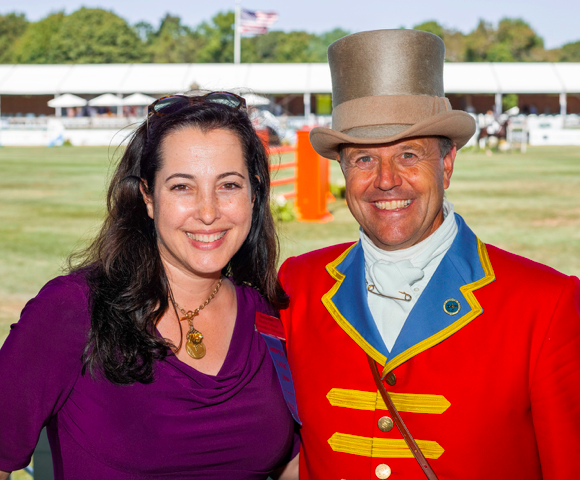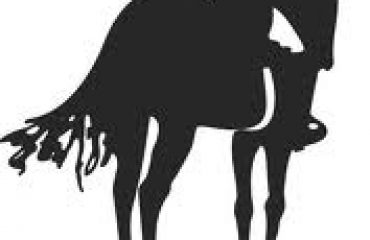It’s no secret to those who know me that the Hampton Classic holds a special place in my heart. I have been blessed to have had a few riding career highlights at the Classic—winning the Grand Prix Qualifier and the featured Sunday Grand Prix in 2008 were two standouts. There were character-building moments along the way as well (being launched mid-jump in the grand prix the year prior comes to mind). The Hampton Classic was and still is much more than a competition—it was a time for family, for friends, for camaraderie, and for an atmosphere like no other. You can imagine my shock (and indignation) to hear “my” beloved grass grand prix ring received a makeover this year. I knew there had to be a good reason for it, and there’s no better woman to give us the scoop than Shanette Barth Cohen. After all, she’s seen a few challenges in her time as the Executive Director of the Hampton Classic since taking the reins in 2005. I affectionately called her the “Queen of Contingency Plans” when I had the pleasure of catching up with her. We recalled some of those feats that led to my half-joking nickname, like the great tear-down and rebuild of 2011 during Hurricane Irene. You won’t believe the laundry list of moving parts it took to tear up and replace the world-famous grass ring. What started out as a conversation to catch up and get the details on the stadium turned into an uncovering of Shanette’s leadership methods and unique style—a closer look at what it takes to truly lead a team and create a Hampton Classic family. I got a truer glimpse of just why the Hampton Classic feels like home.
HD: Shanette, walk me through this year’s show. Could you give us an overview of how the week unfolded?
SBC: We work on the show year-round, but the building of this horse show starts in earnest in late July, early August. When I think about this week, I kind of have to back up because the weekend before the Hampton Classic’s Opening Weekend we had the Hurricane Henri scare. So the prediction was that we could be getting a real hurricane, certainly a tropical storm coming through here. With the predicted weather, we made the decision to tear all the tents down the way we did in 2011 when Hurricane Irene came through. We had 1600 stalls, and more than 80 boutiques, all the VIP tents, all the little tents at the gates and ingates— all over the place!
That was coupled with the fact that we had actually a smaller staff than we normally would, because for a variety of reasons. A big one is Traverse City Horse Shows, Michigan, which didn’t exist in 2019, is now on our dates, and it’s a lot of the same people. When people think about the mileage rule, it’s not just about who you get to show, it’s the staff. So a lot of the people that were working in Michigan, who would normally be working at The Hampton Classic, weren’t here. We had a smaller staff than normal, had trouble hiring, finding more qualified people to work on our crew. Then we had to take everything down and rebuild it. So we were catching up for this year and also we didn’t happen in 2020. These were just some of our challenges!
HD: It’s quite the undertaking—a very precise operation to put on a prestigious event like the Hampton Classic. As you emphasized, it’s not a “day of” or even “week of” process. I am always blown away by all that goes into these premier events—and that is under “normal” circumstances. You seem to get some real “curveballs”…
SBC: By the time Opening Day rolled around, I was thrilled! So many people when they were getting here said, “Wow, the showgrounds look amazing!” Opening Day was a beautiful day, and it was going spectacularly well, and then the first class started on our field. It was apparent immediately that the footing was just not good enough. We did a major million-dollar renovation of the Grand Prix field before the 2019 Hampton Classic, so it was heartbreaking watching it not hold up.
Alan Reinheimer, our manager, Lisa Deslauriers, who is our Event Chairperson, Dennis Suskind, our Board President, Georgina Bloomberg, who is on our Executive Committee of our Board, and I, met in the ring. We also had input from Alan Wade, our course designer, and some of the other course designers. We decided the best plan was to pull the grass up and then add in some additional footing material, and get it in good enough shape to ride on that. Those are not the kinds of major changes that you would do during a horse show. Luckily on a Sunday evening, we were able to get that started.
HD: That’s incredible – what an incredible team effort. It’s safe to say it’s unprecedented, right?
SBC: I would think so. I’m so grateful for every person we have working with the Hampton Classic. The nice thing is we’ve had such a good group for quite some time, so everyone knows their jobs. When we had to pivot and make a new plan, everyone just jumped in full steam ahead and got it done. I’m sure there are other shows that could probably pull something like that off. but I wasn’t sure if we could do it, but we did, and I am so appreciative that that was able to happen.
HD: You’ve obviously had to step back and punt now a couple of times, and you’ve been prepared to do so probably a few more times than that. The banker in me now wants to know, how did you do it? Insurance? Is it support from your donors? A loan?
SBC: I think that’s a good question for 2020 as well when we had to miss the horse show altogether. Because we’re a nonprofit, we don’t have a whole lot in reserves, and we have no form of income to keep us going beyond what comes in for the horse show. We really relied upon our supporters, on the typical table patrons, especially the personal table patrons, many of whom do it to be here. But also because we’re a nonprofit, they get a tax deduction. We went to a lot of them and said, “Is there any way you can help us get through the year because we want to survive and be back in 2021?” As challenging as last year was, it was so heartwarming how quickly people responded saying, “Yes, of course.” Some gave us the exact same amount they gave when they have a table, others gave smaller donations, but every dollar was so welcomed [and truly appreciated]. We also had some benefit clinics. Daniel Bluman came and did a 2-day clinic where he donated his time, and all the money went to help support the show and get us to next year. Joe Fargis did four days of clinics in the area. It’s those kinds of things that helped us [and continue to help us]. We ended up having to furlough a big chunk of our staff for a period of time and then brought everyone back. Those of us who were still here, we took pay cuts to just keep going, but we made it through the year.
 I don’t know how much it’s going to ultimately cost to finish the field. Even though we got through this year, we can’t just leave it as it is. We need to evaluate what is the best footing, and what we want to do. We reached out to those who have supported the show and we did quite well from a corporate sponsor standpoint. We rely on corporate sponsorships a lot, and we try and deliver value so that it’s a marketing buy from them. It’s not a donation. We do everything we can to make it a valuable business decision for them. That’s only possible when we actually have a horse show.
I don’t know how much it’s going to ultimately cost to finish the field. Even though we got through this year, we can’t just leave it as it is. We need to evaluate what is the best footing, and what we want to do. We reached out to those who have supported the show and we did quite well from a corporate sponsor standpoint. We rely on corporate sponsorships a lot, and we try and deliver value so that it’s a marketing buy from them. It’s not a donation. We do everything we can to make it a valuable business decision for them. That’s only possible when we actually have a horse show.
With these extra unanticipated costs, we’ll probably still be in the black. We had other capital improvements we wanted to start doing: we need to upgrade our schooling areas for the jumper rings, we always have a very long list of capital improvements we’d like to make. Some of those may have to wait a little bit longer. The priority now is making sure the Grand Prix footing is at its best.
HD: How do you lead or motivate your team, especially in the face of a massive undertaking like you had this year? Not to mention those over all the years!
SBC: I try to empower my team members to own their areas of responsibility and I don’t micromanage them. I encourage input from everyone, regardless of the organizational chart. I’d like to think this management style helps keep everyone personally invested in the success of the show. They know their jobs and they’re able to mobilize quickly in times of crisis. While it’s important to understand where break-downs happened so they don’t happen again, during a challenge I make finding and executing a solution the priority and save the post-mortem for later. I believe the motivation comes from year-round efforts, not something that gets turned on and off as challenging situations arise.
HD: You have truly been a remarkable leader of the Hampton Classic and the team it takes to run it. What advice can you give other leaders under pressure?
SBC: Lead by example – keep your emotions in check, stay focused on solutions, and address issues immediately so they don’t fester and become bigger issues than necessary. Also, I think it’s important that only those who’re involved with putting out a metaphorical fire need to know about the fire.
HD: What is something you have learned over your years as the Executive Director of the Hampton Classic?
SBC: I’ve learned the most important key to success is to have excellent people on your team. When bringing in someone new, I’m less concerned about them having specific relevant experience than having folks who are dedicated, smart, resourceful, and reliable. I’m so lucky to have such an amazing group of staff, crew, and officials working at the Hampton Classic.
HD: There is so much history and tradition at the Hampton Classic! What is something that you believe will always remain a tradition or fixture? Other than the Grand Prix ring, what is something that has changed or evolved over the years?
SBC: We take the word “classic” in our name seriously – we try to keep the show’s culture and atmosphere the same while always trying to improve and stay relevant. I think one tradition that will always remain is our “Local Day” divisions and how the show is a home horse show for so many. We’re always looking to get better, so over time, there have been things that have changed that might not be evident from one year to the next, but they can appear more dramatic if you haven’t been here in a while. Our food offerings, vendor areas, FEI division, and charitable activations are a few elements that have evolved in the 15-years I’ve been on board.
HD: Favorite part of the Hampton Classic?
SBC: My favorite part of the Classic is when our seasonal crew and officials start arriving – it’s like a family reunion.





